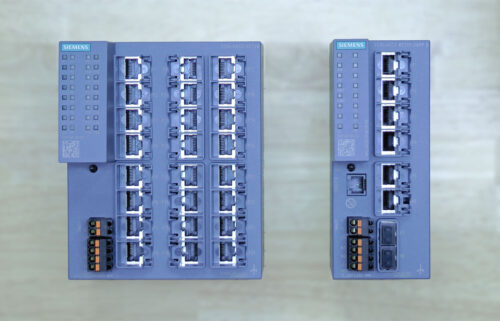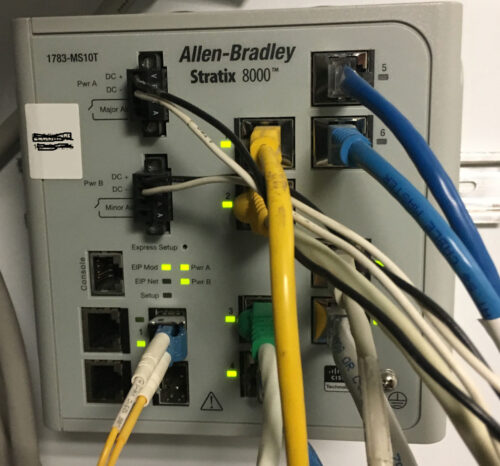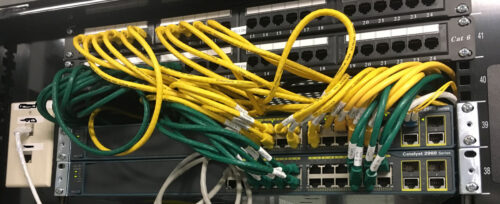
Like many other people that work in controls and automation, I came from an electrical and instrumentation background and did not have any experience with network design, configuration or maintenance.
Thankfully, my first job was a mill startup and I was able to learn many things that would be a foundation for the years ahead. Things like how to test and terminate fiber and UTP (unshielded twisted pair) for EtherNet communication.
 Above: Scalance Unmanaged and Managed Industrial Switches.
Above: Scalance Unmanaged and Managed Industrial Switches.
Image By Shawn Tierney. Special thanks to Siemens for the samples.
Soon thereafter, I would have to learn how to load switch backups to replace a failed switch. The list goes on, but as the needs for network skills have increased over the years, I have had to create a constant plan of learning to keep up with the direction of the industry.
There are so many options on the market today for network switching devices. If you plan to implement a new switch for a small system or are planning an entire network, where do you start?
Image by: Brandon Cooper

Vendor Considerations
Whether you are using ABB, Honeywell, Rockwell, Siemens, Emerson or any other control system or systems in your install base, they will all have a preferred line of network equipment that they have tested and approved for their respective systems.
The said company will also have network design considerations that are approved and tested as well.
It doesn’t mean other types of “non-approved” network equipment will not work with their control system, only that they have not been tested and guaranteed. Company specific documentation is the first place I would begin when planning for a network.
Scalability
Thinking about setting up a new control system and you need to install new network equipment for the system. Ask yourself a few questions:
- Will this system be isolated from other systems (aka stand-alone) or will it be part of a larger, overall network?
- What are the plans for the future of this system? Will it be part of a larger network one day?
- What are the security risks for this system?
Asking yourself the above questions will help you with the decision of whether you will need a managed switch or unmanaged switch.
Some considerations of a Managed Switch:
- Network configuration allows for traffic segregation for multiple networks (VLANS)
- Remote access for switch monitoring and configuration
- Security features like being able to disable ports, detecting unauthorized access and a myriad of other security functions
- Capable of providing diagnostic data to OT systems and IIoT systems
- Capable of Fault Tolerant, Redundant and Ring Topologies
- Requires specific skillset for setting up and maintenance
- More expensive
Some considerations of an Unmanaged Switch:
- No configuration necessary
- Access devices are essentially plug and play
- Inexpensive
- Higher security risk potential
Other Considerations
Redundancy
Depending on the criticality of this device:
-
- Does it need to be redundant?
- Does it support network redundancy?
- Does it support redundant power supplies?
Devices that support network redundancy and power redundancy will be higher end devices.
They will cost more, be managed and can be industrial grade, but will provide the uptime needed if the device is critical.
Environment
Is an industrial grade switch needed?
-
- Will this device be in a cabinet that can and will be locked?
- Will this device be in an air-purified environment or a harsh environment?
If the device cannot be locked up, the security risk is greater and if the device is in a harsh environment, it needs to be industrial grade.
Conclusion
There are many variables to take into consideration when looking for a network switch to meet your needs.
Generally, the more resilient and configurable, the more the cost will be. The simple, lower cost switch will also meet the needs and perform the required function with much less cost, time and resources.
Whatever your network needs are, I hope this gives you valuable considerations to think about as you plan for your network needs.
Written by Brandon Cooper
Senior Controls Engineer and Freelance Writer
Have a question? Join our community of pros to take part in the discussion! You'll also find all of our automation courses at TheAutomationSchool.com.
Sponsor and Advertise: Get your product or service in front of our 75K followers while also supporting independent automation journalism by sponsoring or advertising with us! Learn more in our Media Guide here, or contact us using this form.
- Things I’ve Learned Travelling for Work (2) - July 17, 2025
- Things I’ve Learned Travelling for Work (1) - July 10, 2025
- Emulating an Allen-Bradley E3 or E3 Plus - June 30, 2025

Discover more from The Automation Blog
Subscribe to get the latest posts sent to your email.






